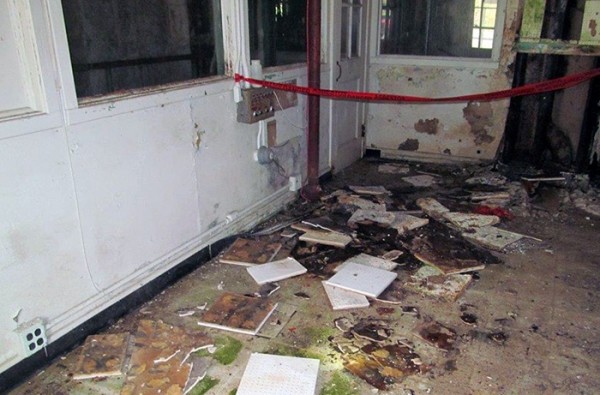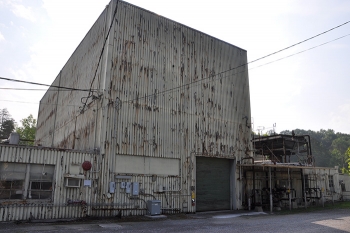
Workers remove combustible items from the Homogenous Reactor Experiment facility, or Building 7500, at Oak Ridge National Laboratory, which allowed the building’s heat detection system to be deactivated. (Photo by DOE/ORNL)
By DOE Office of Environmental Management
The U.S. Department of Energy Office of Environmental Management and its cleanup contractor in Oak Ridge are taking steps to remove risks and help prepare excess facilities for eventual demolition at the Y-12 National Security Complex and Oak Ridge National Laboratory.
Oak Ridge is home to more than 350 excess facilities totaling more than six million square feet. Many of them are several decades old.
Alan Stokes, associate director for the Planning and Execution Division in Oak Ridge’s Environmental Management, or EM, program, said during a panel discussion this month at the 2017 Waste Management Symposium in Phoenix that Oak Ridge has more than a quarter of the “higher-risk” excess facilities in the entire DOE inventory.
Several projects are already under way at some of these excess facilities to perform characterization, abate hazards, and stabilize them, which will reduce eventual demolition risks and costs, Stokes said.

A look at the deteriorated conditions inside the Homogenous Reactor Experiment facility, or Building 7500, at Oak Ridge National Laboratory. (Photo by DOE/ORNL)
One recently completed project was the removal of all combustible materials from the Homogenous Reactor Experiment facility, also known as Building 7500, at ORNL. As a result, the Oak Ridge Office of Environmental Management, or OREM, and cleanup contractor URS-CH2M Oak Ridge LLC, or UCOR, were able to deactivate the heat detection system and eliminate the need for personnel to enter the building to periodically inspect the system and thereby reduce potential risks, Stokes said.
At the waste management conference in Phoenix this month, Ron Slottke, director for Project Services and Support at UCOR, said additional hazards abatement work is planned for this year at Building 7500. This summer, efforts to prepare the facility for demolition will take another significant step forward, when workers are set to remove asbestos from the building and drain and grout a portion of the flooded basement.
Building 7500 was constructed in 1951 as a research reactor, and it operated until the 1980s supporting various missions. The 14,695-square foot, three-level structure has degraded throughout the years. The roof is beyond repair and allows water to enter the building, which accelerates the structure’s degradation and keeps the basement flooded.
“The projects funded through the Excess Facilities initiative are not only improving safety for the future, but they are also providing immediate benefits,” OREM Acting Manger Jay Mullis said. “The upcoming work at this facility will further reduce safety and environmental concerns and keep it in a manageable state until it can be demolished.”
During the panel discussion this month, Slottke highlighted other recently completed risk reduction projects, including:
- Risk reduction activities at ORNL’s Building 3026 Hot Cells, including sealing the hot cells and capping pedestals with concrete to prevent the spread of contamination.
- Roof repairs at Y-12’s Alpha-4 building, which prevents water damage that would cause rapid structural deterioration and the spread of contamination.
- Initiation of deactivation activities at the COLEX West outside Y-12’s Alpha-4 building, which involves cleaning out and preparing the old, hazardous, mercury-contaminated equipment for removal.
- Characterization activities at Y-12’s Biology Complex, which involved sampling at more than 350 locations to complete the preliminary step required for demolition.
Note: This story was published by the U.S. Department of Energy Office of Environmental Management on March 15. This story has been lightly edited.
More information will be added as it becomes available.

A look at the exterior of the Homogenous Reactor Experiment facility, or Building 7500, constructed in 1951 at Oak Ridge National Laboratory. (Photo by DOE/ORNL)
Do you appreciate this story or our work in general? If so, please consider a monthly subscription to Oak Ridge Today. See our Subscribe page here. Thank you for reading Oak Ridge Today.
Copyright 2016 Oak Ridge Today. All rights reserved. This material may not be published, broadcast, rewritten, or redistributed.
Leave a Reply